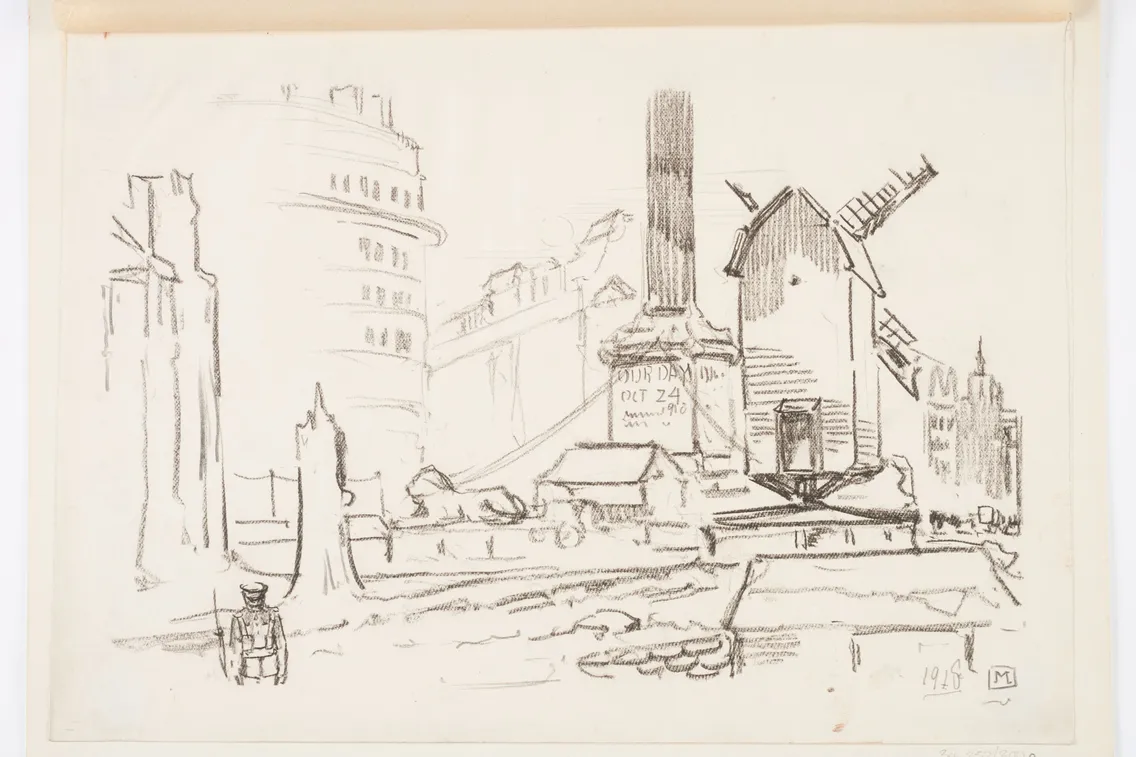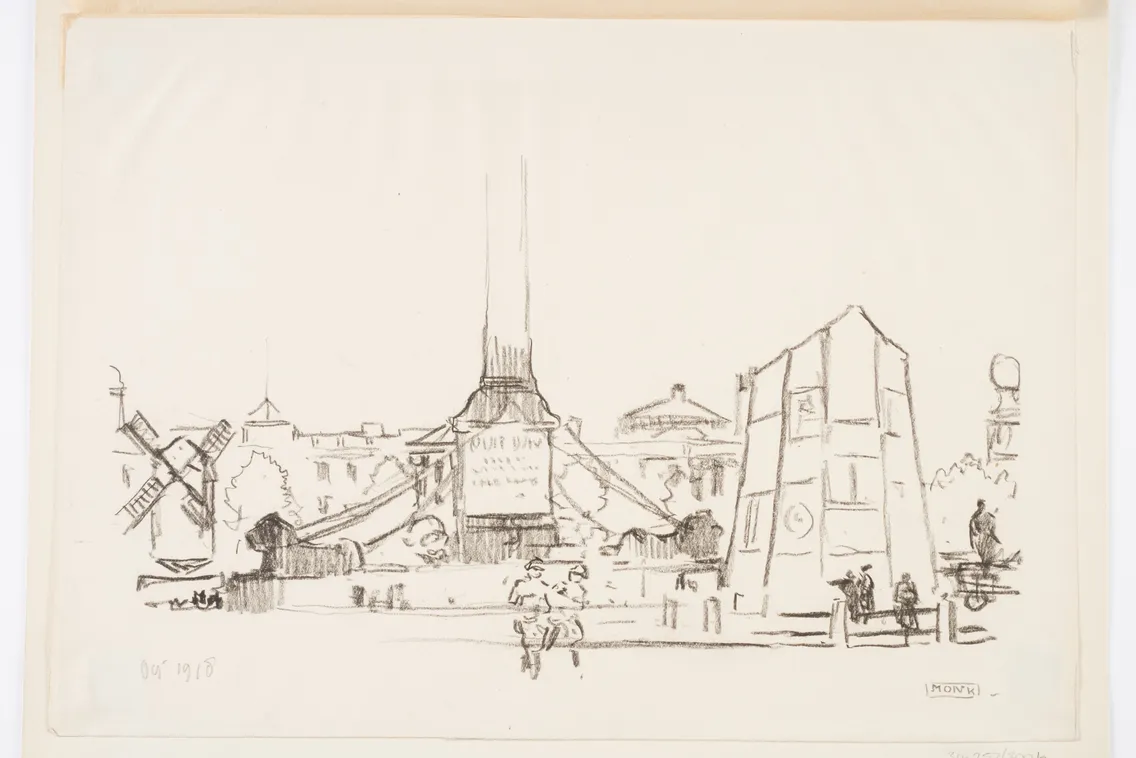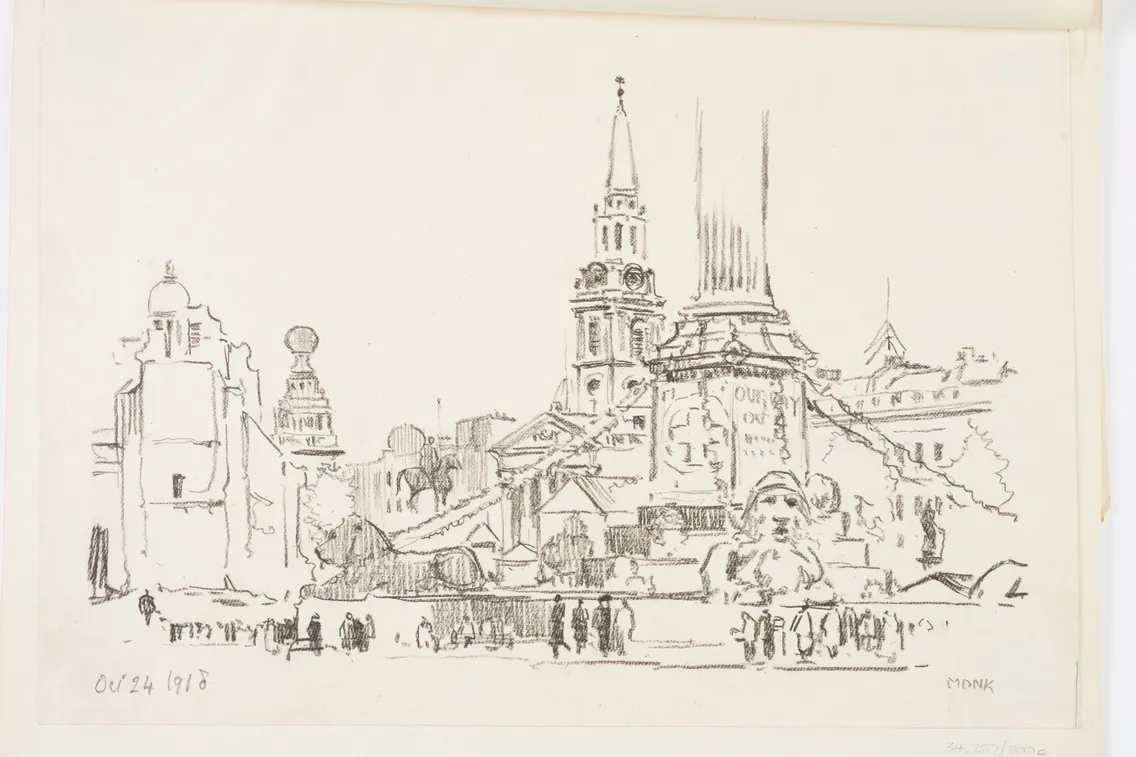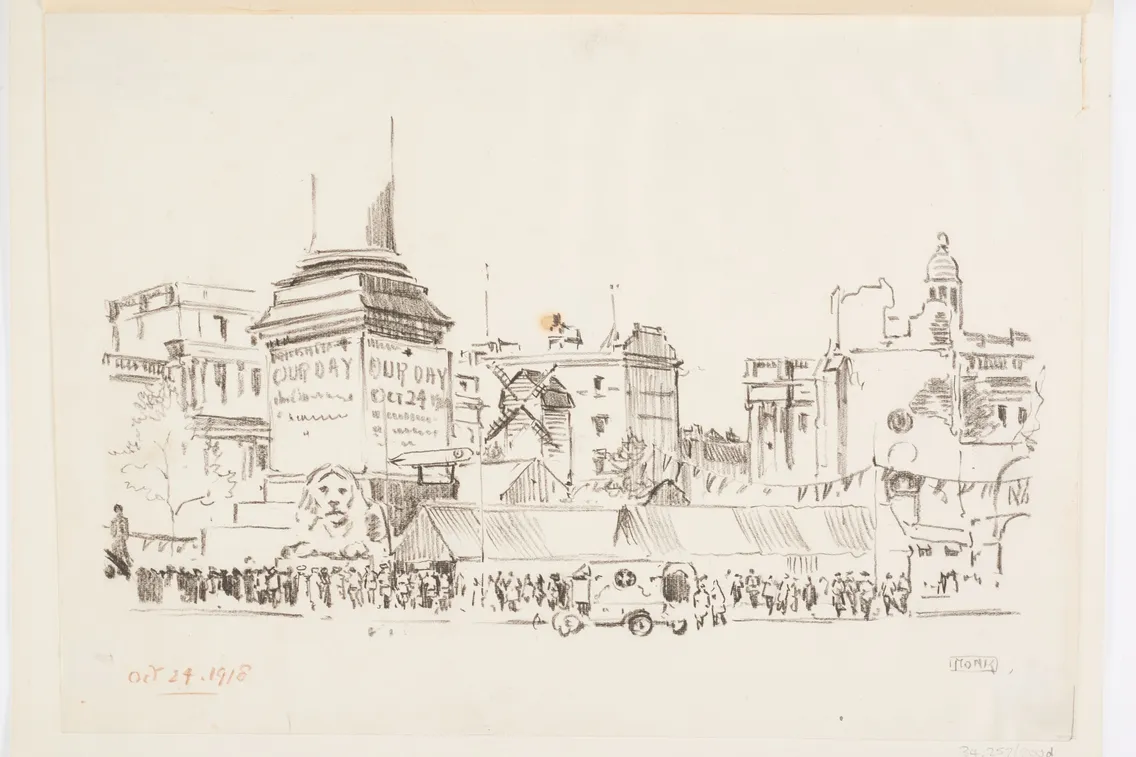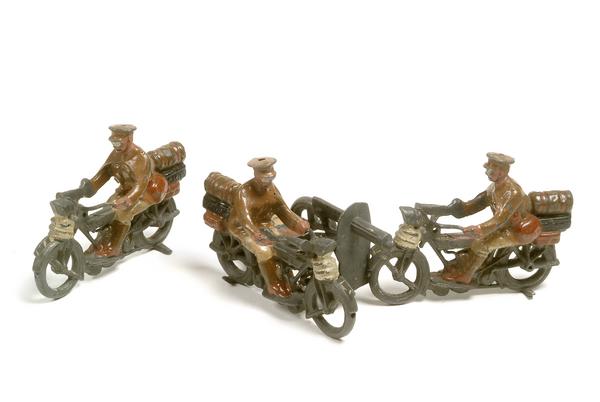30 November 2022 — By Thomas Ardill, Mehzebin Adam-Suter
First World War & the British Red Cross: War art with a difference
How artists documented the British Red Cross’ vital First World War relief efforts through powerful artworks, posters, pins, and capturing nurses, ambulances and fundraising events that raised millions.
During the First World War, many London artists worked with the British Red Cross to support the organisation with its life-saving work – from helping to fundraise for people in crisis to raising awareness of the charity’s vital relief work. They also recorded the extraordinary everyday work of the charity through their art.
The British Red Cross was founded in London in 1870, following the outbreak of the Franco-Prussian War, and from its earliest days, artists played an important role in documenting and promoting its activities. In 1870, the Illustrated London News regularly reported on the activities of the charity, as depicted in a wood engraving of volunteers sorting and packing linen bandages at the London office at 2 St Martin’s Place, Trafalgar Square, in London Museum’s collection. The work of Red Cross personnel and volunteers continued to interest artists as a pictorial subject, and during World War I, both independent artists and British Red Cross volunteers who were working in roles such as nurses and ambulance drivers sketched and painted the charity’s work. Today, these artworks give an insight into the organisation’s work at the time, across the country and continent.
“Women artists played a particularly important role in interpreting and documenting the First World War”
‘Our Day’ captured by William Monk (1863–1937)
A Red Cross fundraising event called ‘Our Day’ was organised for the first time in 1915 and continued to take place annually throughout the First World War. The idea for this was inspired by Queen Alexandra’s Rose Day, when people showed support for the Queen by buying flowers to raise funds for her favourite charities. Painter and printmaker William Monk, one of England’s most famous architectural etchers of the late 19th and early 20th century, sketched the Our Day activities in Trafalgar Square on 24 October 1918. According to The Times (25 October 1918), the main event was a “Camouflage Fair” with a mock “ruined village”. The ruins can be clearly seen in three of the drawings from London Museum’s collection.
The fair began with an auction sale of 400 lots of fruit and vegetables donated by the Covent Garden sellers and growers, followed by the sale of Mr George Robey’s “famous pig ‘Daisy’, given to the Queen by suburban allotment holders and afterwards presented by her to the Red Cross Society.” While Monk, unfortunately, did not draw Daisy, he did walk all around the square to sketch it from each corner. Our Day posters are attached to each side of the base of Nelson’s Column. In the final drawing, we can see the “sign of the airship” attached to the base of the column to the right of the lion sculpture.
VAD nurse at work by Joyce Dennys (1893–1991)
Women artists played a particularly important role in interpreting and documenting the First World War, capturing the impact of conflict and the experiences of women who carried out humanitarian work in Britain and overseas. In the British Red Cross Museum collection, a majority of the artworks from the First World War are by women artists.
Joyce Dennys was a well-known illustrator, playwright and author. When the outbreak of the First World War interrupted her studies at the London School of Art, she worked as a Voluntary Aid Detachment (VAD) with the British Red Cross from 1914 to 1917. She recorded her experiences with various sketches, some of which are now in the British Red Cross Museum collection.
One of Dennys’ well-known works is a First World War recruitment poster featuring VAD members of the British Red Cross, the Order of St John, and the Territorial Force. It’s believed that the response to the poster was so great that no other VAD recruitment poster was needed.
Close to the front line by Olive Mudie-Cooke (1890–1925)
During the First World War, female artists were not officially commissioned to enter the war zone. However, some found themselves close to the front line while working in hospitals and ambulance units. Olive Mudie-Cooke was born in West London and studied art at St John’s Wood Art School and at Goldsmiths’ College.
She worked in France and Italy from 1916, driving ambulances for the First Aid Nursing Yeomanry and later the British Red Cross, as well as working as an interpreter. While working as a VAD, Mudie-Cooke began to sketch and paint the scenes she saw around her, including ambulance drivers and medical staff. Her works bring to life the humanitarian work carried out by British Red Cross volunteers close to the front line.
Campaigning and fundraising
The Red Cross has always had a distinctive emblem. Building on this, artists and graphic designers have played an essential role in raising the organisation’s visibility and promoting its campaigns by designing posters, stamps, badges and other products for the charity. Since the early days of the Red Cross Movement, these items became vital communication and fundraising tools.
Fundraising posters by Tom Purvis (1888–1959)
Tom Purvis was widely known as one of the most important English poster artists of his day. He is best known for his work with Austin Reed, London Underground, and London and North Eastern Railway. During the First World War, he was commissioned by the Joint War Committee of the British Red Cross and the Order of St John to design several fundraising posters. His striking designs promoted the British Red Cross and raised awareness of the needs of the sick and wounded.
Art stamps by Edmund Dulac (1882-1953) and Frank Brangwyn (1867–1956)
Artists also designed fundraising products on a much smaller scale. In 1914-15, the Daily Mail and Evening News issued two sets of six ‘Art Stamps’ for sale in aid of the Children’s Red Cross Fund.
One set, designed by French-born London-based book and magazine illustrator Edmund Dulac, depicts personifications of ‘Assistance’, ‘Hope’, ‘Courage’, ‘Faith’, ‘Victory’ and ‘Alliance’ in a stylish Roman-meets-Art Deco manner. The other, by artist Frank Brangwyn, depicts scenes of injured and weary-looking soldiers receiving assistance from Red Cross nurses.
Brangwyn, who had Welsh heritage but was born in Belgium and lived in London, also supported the Belgium Red Cross by selling limited editions of his lithograph of the Last Boat to Leave Antwerp (1917).
Red Cross pins
To further support ‘Our Day’ fundraising activities, artists designed small flags to be sold by street collectors. Small paper flags were sold for a penny, and silk flags were sold for sixpence. Many designs were issued, from simple red crosses against a white flag to images of doves and ambulances. By the end of the war, around £8 million (around £300 million today) had been raised through Our Days across the world.
And the legacy continues
Artists have continued to support the British Red Cross throughout its history by recording the work of the charity, designing posters and other promotional material, and selling works in support of the charity. For example, in 2021, Yinka Ilori MBE was commissioned by the British Red Cross to celebrate the many acts of kindness during the Covid-19 pandemic by painting a 15ft mural on Whitby Street in Shoreditch, East London.
Both British Red Cross Museum and London Museum, among others, have similar examples of how artists have collaborated to document and promote the incredible work of the British Red Cross, the world’s emergency responders.
Mehzebin Adam-Suter is Curator (British Red Cross Museum & Archives) and Thomas Ardill is Curator (Paintings, Prints and Drawings, London Museum)
British Red Cross Museum and London Museum have many more related artworks in our collections, so please get in touch or visit to know more.
This partnership was supported using public funding from Arts Council England.


